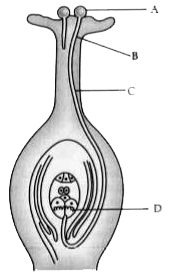Complete Solutions to TOPIC - 2 (SEXUAL REPRODUCTION IN PLANTS)(SHORT ANSWER TYPE QUESTIONS - II) of chapter HOW DO ORGANISMS REPRODUCE? of Class 10 book with complete answers and questions
| Class 10 | BIOLOGY |
| Chapter | HOW DO ORGANISMS REPRODUCE? |
| OSWAAL PUBLICATION | TOPIC - 2 (SEXUAL REPRODUCTION IN PLANTS)(SHORT ANSWER TYPE QUESTIONS - II) |
| Number Of Questions | 17 |
| Academic Year | 2023-24 |
Name the parts A, B and C shown in the diagram and write their functions.

View SolutionWhat is meant by pollination? Name and differentiate between the two types of pollination.
View SolutionDescribe in brief the function of various parts of female reproductive part of bisexual flower.
View SolutionName three parts of carpel and give one function each.
View Solution(i) Why is vegetative propagation practised for growing some types of plants?
(ii) Name the different parts of a flower that has germ cells.
(iii) List any two agents of pollination.
View Solution(i) What is the difference between self-pollination and cross pollination?
(ii) What happens to the pollen which falls on a suitable stigma? Explain.
View SolutionEnumerate the method of fertilisation as seen in a flowering plant.
View SolutionWhat is a seed ? How does it help in reproduction in plants?
View SolutionMention the important post-fertilisation changes in the flower.
View SolutionWhat is sexual reproduction? List its four significance.
View SolutionDraw longitudinal section of a bisexual flower and label the following parts on it :

(i) Anther, (ii) Ovary, (iii) Stigma, (iv) Style.
View SolutionName the parts A, B and C shown in the following diagram and state one function of each.

View SolutionIn a germinating seed, which parts are known as future shoot and future root? Mention the function of cotyledon.
View Solution(a) List two reasons for the appearance of variations among the progeny formed by sexual
(b) reproduction.
(i) Name the part marked 'A' in the diagram.
(ii) How does 'A' reaches part 'B'?
(iii) State the importance of the part 'C'.
(iv) What happens to the part marked ‘D’ after fertilization is over?

View SolutionName the reproductive parts of an angiosperm. Where are these parts located? Explain in brief the structure of its female reproductive parts.
View SolutionDraw a diagram of the longitudinal section of a flower exhibiting germination of pollen on stigma and label
(i) Ovary, (ii) Male germ-cell, (ii) Female-germ cell and (iv) ovule on it.
View Solution(i) Draw a neat labelled diagram of a germinated seed and label radicle, plumule and cotyledon.
(ii) Mention function of each of these parts.
View Solution
TOPIC - 2 (SEXUAL REPRODUCTION IN PLANTS)(SHORT ANSWER TYPE QUESTIONS - II) questions and complete solutions for chapter HOW DO ORGANISMS REPRODUCE? of OSWAAL BIOLOGY (KANNADA ENGLISH) of Class 10
All Exercises from OSWAAL PUBLICATION Class 10 BIOLOGY HOW DO ORGANISMS REPRODUCE?
- NCERT CORNER (TEXTBOOK EXERCISES)
- NCERT CORNER (INTEXT QUESTIONS)
- TOPIC - 1 (BASICS OF REPRODUCTION, ASEXUAL REPRODUCTION AND VEGETATIVE PROPAGATION)(LONG ANSWER TYPE QUESTIONS)
- TOPIC - 1 (BASICS OF REPRODUCTION, ASEXUAL REPRODUCTION AND VEGETATIVE PROPAGATION)(MATCH THE COLUMN)
- TOPIC - 1 (BASICS OF REPRODUCTION, ASEXUAL REPRODUCTION AND VEGETATIVE PROPAGATION)(MULTIPLE CHOICE QUESTIONS)
- TOPIC - 1 (BASICS OF REPRODUCTION, ASEXUAL REPRODUCTION AND VEGETATIVE PROPAGATION)(SHORT ANSWER TYPE QUESTIONS - I)
- TOPIC - 1 (BASICS OF REPRODUCTION, ASEXUAL REPRODUCTION AND VEGETATIVE PROPAGATION)(SHORT ANSWER TYPE QUESTIONS - II)
- TOPIC - 1 (BASICS OF REPRODUCTION, ASEXUAL REPRODUCTION AND VEGETATIVE PROPAGATION)(VERY SHORT ANSWER TYPE QUESTIONS)
- TOPIC - 2 (SEXUAL REPRODUCTION IN PLANTS)(LONG ANSWER TYPE QUESTIONS)
- TOPIC - 2 (SEXUAL REPRODUCTION IN PLANTS)(MATCH THE COLUMN)
- TOPIC - 2 (SEXUAL REPRODUCTION IN PLANTS)(MULTIPLE CHOICE QUESTIONS)
- TOPIC - 2 (SEXUAL REPRODUCTION IN PLANTS)(SHORT ANSWER TYPE QUESTIONS - I)
- TOPIC - 2 (SEXUAL REPRODUCTION IN PLANTS)(SHORT ANSWER TYPE QUESTIONS - II)
- TOPIC - 2 (SEXUAL REPRODUCTION IN PLANTS)(VERY SHORT ANSWER TYPE QUESTIONS)
- TOPIC - 3 (REPRODUCTION IN HUMAN BEINGS)(LONG ANSWER TYPE QUESTIONS)
- TOPIC - 3 (REPRODUCTION IN HUMAN BEINGS)(MATCH THE COLUMN)
- TOPIC - 3 (REPRODUCTION IN HUMAN BEINGS)(MULTIPLE CHOICE QUESTIONS)
- TOPIC - 3 (REPRODUCTION IN HUMAN BEINGS)(SHORT ANSWER TYPE QUESTIONS - I)
- TOPIC - 3 (REPRODUCTION IN HUMAN BEINGS)(SHORT ANSWER TYPE QUESTIONS - II)
- TOPIC - 3 (REPRODUCTION IN HUMAN BEINGS)(VERY SHORT ANSWER TYPE QUESTIONS)